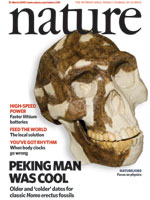| Location: Home > News > Events |
| Nature: Peking man was cool |
|

The age of Homo erectus, known familiarly as Peking Man, has been hotly debated. This week Shen et al. use a recently developed dating technique that computes deposits to be about 770,000 years old — about 300,000 years earlier than usually thought. The cover shows a replica skull reconstructed from several H. erectus fossils from Zhoukoudian. [Image: Skulls Unlimited International, Inc.] LetterNature 458, 198-200 (12 March 2009) | Age of Zhoukoudian Homo erectus determined with 26Al/10Be burial datingGuanjun Shen1, Xing Gao2, Bin Gao1 & Darryl E. Granger3
Correspondence to: Guanjun Shen1Darryl E. Granger3 Correspondence and requests for materials should be addressed to G.S. (Email: gjshen@njnu.edu.cn) or D.E.G. (Email: dgranger@purdue.edu). The age of Zhoukoudian Homo erectus, commonly known as `Peking Man`, has long been pursued, but has remained problematic owing to the lack of suitable dating methods1,2,3,4,5,6,7. Here we report cosmogenic 26Al/10Be burial dating of quartz sediments and artefacts from the lower strata of Locality 1 in the southwestern suburb of Beijing, China, where early representatives of Zhoukoudian Homo erectus were discovered. This study marks the first radioisotopic dating of any early hominin site in China beyond the range of mass spectrometric U-series dating. The weighted mean of six meaningful age measurements, 0.77
|
 0.08 million years (Myr, mean
0.08 million years (Myr, mean  0.68 to 0.78 Myr ago. These ages are substantially older than previously supposed and may imply early hominin`s presence at the site in northern China through a relatively mild glacial period corresponding to MIS 18.
0.68 to 0.78 Myr ago. These ages are substantially older than previously supposed and may imply early hominin`s presence at the site in northern China through a relatively mild glacial period corresponding to MIS 18.